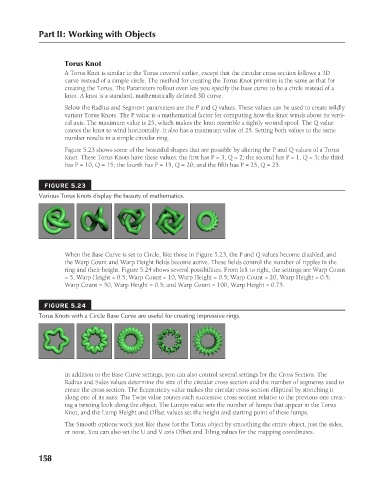Page 206 - Kitab3DsMax
P. 206
Part II: Working with Objects
Torus Knot
A Torus Knot is similar to the Torus covered earlier, except that the circular cross section follows a 3D
curve instead of a simple circle. The method for creating the Torus Knot primitive is the same as that for
creating the Torus. The Parameters rollout even lets you specify the base curve to be a circle instead of a
knot. A knot is a standard, mathematically defined 3D curve.
Below the Radius and Segment parameters are the P and Q values. These values can be used to create wildly
variant Torus Knots. The P value is a mathematical factor for computing how the knot winds about its verti-
cal axis. The maximum value is 25, which makes the knot resemble a tightly wound spool. The Q value
causes the knot to wind horizontally. It also has a maximum value of 25. Setting both values to the same
number results in a simple circular ring.
Figure 5.23 shows some of the beautiful shapes that are possible by altering the P and Q values of a Torus
Knot. These Torus Knots have these values: the first has P = 3, Q = 2; the second has P = 1, Q = 3; the third
has P = 10, Q = 15; the fourth has P = 15, Q = 20; and the fifth has P = 25, Q = 25.
FIGURE 5.23
Various Torus Knots display the beauty of mathematics.
When the Base Curve is set to Circle, like those in Figure 5.23, the P and Q values become disabled, and
the Warp Count and Warp Height fields become active. These fields control the number of ripples in the
ring and their height. Figure 5.24 shows several possibilities. From left to right, the settings are Warp Count
= 5, Warp Height = 0.5; Warp Count = 10, Warp Height = 0.5; Warp Count = 20, Warp Height = 0.5;
Warp Count = 50, Warp Height = 0.5; and Warp Count = 100, Warp Height = 0.75.
FIGURE 5.24
Torus Knots with a Circle Base Curve are useful for creating impressive rings.
In addition to the Base Curve settings, you can also control several settings for the Cross Section. The
Radius and Sides values determine the size of the circular cross section and the number of segments used to
create the cross section. The Eccentricity value makes the circular cross section elliptical by stretching it
along one of its axes. The Twist value rotates each successive cross section relative to the previous one creat-
ing a twisting look along the object. The Lumps value sets the number of lumps that appear in the Torus
Knot, and the Lump Height and Offset values set the height and starting point of these lumps.
The Smooth options work just like those for the Torus object by smoothing the entire object, just the sides,
or none. You can also set the U and V axis Offset and Tiling values for the mapping coordinates.
158
6/30/10 3:35 PM
11_617779-ch05.indd 158 6/30/10 3:35 PM
11_617779-ch05.indd 158

